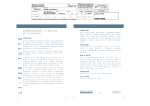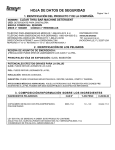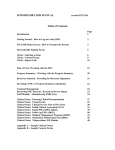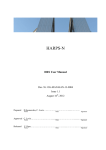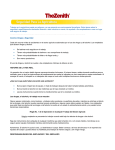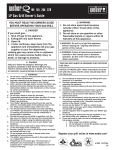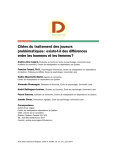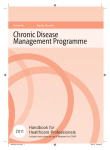Download Screening for bipolar disorders in Spanish
Transcript
Available online at www.sciencedirect.com Comprehensive Psychiatry 51 (2010) 552 – 556 www.elsevier.com/locate/comppsych Screening for bipolar disorders in Spanish-speaking populations: Sensitivity and specificity of the Bipolar Spectrum Diagnostic Scale–Spanish Version Gustavo Héctor Vázqueza,⁎, Ester Romerob , Fernando Fabreguesc , Ronald Piesd,e , Nassir Ghaemie , Manuel Mota-Castillof a Department of Neuroscience, University of Palermo, Buenos Aires, Argentina Department of Psychology, El Salvador University, Buenos Aires, Argentina c Hospital de Clínicas, University of Buenos Aires, Buenos Aires, Argentina d Department of Psychiatry, SUNY Upstate Medical University, Syracuse, NY, USA e Department of Psychiatry, Tufts University School of Medicine, Boston, MA, USA f St. Matthews Medical School, Orlando, FL, USA b Abstract Background: Bipolar disorder is commonly misdiagnosed, perhaps more so in Latin American and Spanish-speaking populations than in the United States. The Bipolar Spectrum Diagnostic Scale (BSDS) is a 19-item screening instrument designed to assist in screening for all types of bipolar disorder. Methods: The authors investigated the sensitivity of a Spanish-language version of the BSDS in a cohort of 65 outpatients with a diagnosis of bipolar disorder, based on a semi-structured interview and Diagnostic and Statistical Manual of Mental Disorders, Fourth Edition, Text Revision criteria. To determine specificity, we assessed a control group of 36 outpatients with diagnosis of unipolar major depressive disorder. Results: The overall sensitivity of the BSDS Spanish version with bipolar disorders types I, II, and NOS was 0.70, which was slightly lower than the sensitivity in the study using the English version of the BSDS (0.76). The specificity was 0.89. When the threshold was decreased from 13 to 12, the sensitivity of the Spanish BSDS increased to 0.76 and specificity dropped to 0.81. Conclusion: The Spanish version of the BSDS is promising as a screening instrument in Spanish-speaking populations. © 2010 Elsevier Inc. All rights reserved. 1. Introduction Although bipolar disorder is commonly misdiagnosed in general [1-3], it appears to be misdiagnosed or ignored even more frequently among Hispanic and Latin American populations, in both clinical and epidemiological settings. Thus, one Argentine study of bipolar disorder demonstrated high rates of misdiagnosis [4]. Furthermore, one of the largest psychiatric epidemiologic studies ever conducted in the US Hispanic community did not even attempt to diagnose bipolar disorders; only unipolar depressive disorders were diagnosed among mood conditions [5]. ⁎ Corresponding author. Department of Neuroscience, University of Palermo, Buenos Aires, Argentina. Tel.: +54 11 4826 0770; fax: +54 11 4826 0770. E-mail address: [email protected] (G.H. Vázquez). 0010-440X/$ – see front matter © 2010 Elsevier Inc. All rights reserved. doi:10.1016/j.comppsych.2010.02.007 Several screening tests and self-completed questionnaires have been developed to facilitate the early detection of bipolar disorder. Hirschfeld et al. [6] introduced the Mood Disorder Questionnaire (MDQ), which demonstrated a sensitivity of 0.73 and a specificity of 0.90, when compared with a semi-structured telephone interview using the Structured Clinical Interview for DSM Disorders (SCID) [7]. In a follow-up study based on a representative US sample, these authors reported a lower sensitivity (0.28) but a greater specificity (0.97) [8]. In another investigation conducted only with bipolar patients, the MDQ yielded a high sensitivity with type I bipolar subjects (0.70) but a low sensitivity (0.30) with type II and bipolar NOS patients [9]. The original Bipolar Spectrum Diagnostic Scale (BSDS) was developed by one of the authors (RP) and later refined and tested by Ghaemi et al. [10]. The BSDS arose from Pies's experience as a psychopharmacology consultant who G.H. Vázquez et al. / Comprehensive Psychiatry 51 (2010) 552–556 was frequently called upon to manage cases of so-called “treatment-resistant depression.” In Pies's experience, most of these cases eventually proved to be undiagnosed bipolar spectrum disorder. The 19 question items on the English version of the BSDS were based on those Pies found most helpful in detecting not only severe cases of bipolar disorder, but also those that fall into the “softer” end of the bipolar spectrum, for example, patients with a history of major depressive episodes and 1 or 2 episodes of elevated mood and energy lasting only 1 to 3 days (and thus not meeting Diagnostic and Statistical Manual of Mental Disorders, Fourth Edition criteria for hypomania) [11]. Understandably, diagnostic errors may lead to inappropriate treatment that can exacerbate the clinical picture, such as antidepressants leading to mania and rapid cycling [12] or first-generation neuroleptics inducing prolonged depressive episodes [13]. Nosologic research on bipolar disorder in Hispanic populations generally has been lacking. Consequently, only 2 screening instruments for bipolar disorder, developed in English (MDQ and the Hypomania/Mania Symptom Checklist [HCL-32], have been translated and validated into Spanish [14,15]. To encourage better diagnosis of bipolar disorder among Spanish-speaking populations, we sought to determine whether the BSDS could detect bipolar disorder in a Latin American sample of patients diagnosed with bipolar disorder. 2. Methods Sixty-five patients with diagnosis of bipolar disorder and thirty six with diagnosis of unipolar depression were recruited from an out-patient private setting. They gave written informed consent to participate in the study after the procedures had been fully explained. All the procedures were conducted in conformity with the argentine laws about research. Among the subjects with bipolarity, 23 subjects had type I bipolar illness; 27 had type II; and 15 had the NOS subtype. Every patient was diagnosed following Diagnostic and Statistical Manual of Mental Disorders, Fourth Edition, Text Revision criteria [16] and using the semi-structured interview from the mood disorders module (SCID for clinicians) [17]. The diagnostic instruments were applied by an experienced investigator, familiar with mood disorders research and clinical treatment (G.H.V.) (Table 1). Diagnoses were made blinded to the scores yielded by the BSDS or any other clinical scale. Patients were then asked to fill out the BSDS scale. The scale was given to patients with a clinical diagnosis of either bipolar or unipolar mood disorder, in order to assess sensitivity and specificity, respectively. Sensitivity was defined as “the probability of a positive test result given that the individual tested actually has the disease” [18] and was assessed using standard statistical methodology, that is, by dividing the number positive on the BSDS scale by 553 Table 1 Clinical and sociodemographic characteristics of the sample Diagnosis group MDD BD Age (y ± SD) Sex (% female) Marital status (%) Single Married or cohabiting Divorced Widowed Educational level (%) Primary Secondary University 48.07 ± 11.2 79.4 45.09 ± 15.07 72.3 21.3 54.4 18.7 5.6 32.3 43.1 21.5 3.1 18.9 47.3 33.8 12.3 44.6 43.1 MDD = major depressive disorder; BD = bipolar disorder. the number of all patients clinically diagnosed with bipolar disorder. Specificity was defined as “the probability of a positive test result given that the individual tested does not have the disease” [18] and was calculated by dividing the number positive on the BSDS scale by the number of all patients clinically diagnosed with unipolar major depressive disorder. One of the authors (MMC) originated a Spanish version of the BSDS for use primarily in American patients of Hispanic origin (Mota-Castillo, personal communication). Subsequently, and in cooperation with Mota-Castillo, a new Spanish version was created, translated from the original English text by two of the Argentinean authors (FF and GHV) and reviewed by the principal author of this article (GHV). This revised Spanish version was then backtranslated [19] by a professional translator and subsequently approved by the BSDS' codevelopers (RP and SNG). The BSDS has 2 sections. The first part includes a series of 19 sentences that describe the main symptoms of bipolar spectrum disorders. Each sentence is linked to a blank space, to be checked by subjects who decide that the statement is an accurate description of their feelings or behaviors. Each selected statement is assigned one point. The second portion of the BSDS asks the subject to select the degree to which the 19-item narrative “fits” their own experience. The scale offers four possibilities: “this story fits me very well, or almost perfectly” (6 points), “this story fits me fairly well” (4 points), “this story fits me to some degree, but not in most respects” (2 points), and “this story doesn't really describe me at all” (0 points). The BSDS scoring ranges from 0 to 25 points. The original validation study [10] assigned a diagnostic value to facilitate its interpretation by clinicians: a total score of 20 to 25 points indicates that bipolar disorder is highly likely; 13 to 19, moderate probability; 7 to 12, low probability; and 0 to 6, bipolar disorder highly unlikely bipolar diagnosis. 3. Results The clinical and demographics of the sample are provided in Table 1. 554 G.H. Vázquez et al. / Comprehensive Psychiatry 51 (2010) 552–556 Using the previously established threshold of 13 points [10], the overall sensitivity of the BSDS Spanish version (with bipolar types I, II and NOS) was 0.70 (46/65) (95% CI, 0.60-0.82). In the unipolar group of patients, only 11% received a false positive diagnosis of bipolarity using the BSDS-S (4/36), indicating a specificity of 0.89 (95% CI, 0.36-0.60). The sensitivity for bipolar I sub-type was 0.69 (16/23) (95% CI, 0.53-0.91), whereas with bipolar II and NOS patients, sensitivity was 0.71 (30/42) (95% CI, 0.58-0.86). The overall sensitivity of the BSDS Spanish version was slightly lower than that reported in the original study conducted in the United States (0.76 for all bipolar subtypes) [10]. However, when the threshold was decreased from 13 to 12, the sensitivity increased to 0.76, whereas the specificity changed from 0.89 to 0.81 (Fig. 1). With respect to question items 1 to 19, the most frequently selected statements among the bipolar group (Fig. 2) were items 1 and 3 (95.4% of cases) and item 5 (93.8%). These statements are designed to probe for a history of major mood fluctuations and depressive symptoms. The least frequently selected statements were numbers 15 (23.1%), 18 (21.5%), and 19 (24.6%). These items were designed to elicit a history of impulsive or anti-social behaviors, such as spending sprees, problems interacting with coworkers, encounters with the legal system, and substance abuse during a manic phase. Comparing the bipolar patient sample answers with those in the unipolar group (χ2 test), we have found items 1, 3, 5, 9, 10, 11, and 16 as the more discriminative ones (P b .001); items 2, 6, 7, 8, 14, 18, and 19 with an intermediate discriminated power (P b .05); and finally, items 4, 12, 13, 15, and 17 without any statistical significant difference between both groups. As noted above, in the second part of the Scale, patients must declare to what degree the “story” they just read (the 19 sentences) describes them. The degree of concordance varies from “this story fits me very well or almost perfectly” (option 1) down to “this story doesn't really describe me at all” Fig. 1. Sensitivity and specificity of the BSDS Spanish version across different thresholds. Fig. 2. Distribution of each sentence checked in the 19-item BSDS-S on patient sample by diagnosis: bipolar (BD) vs unipolar (MDD). (option 4). Most bipolar patients selected option 3 (“this story fits me to some degree, but not in most respects”) (47.7%), followed by option 1 (27.7%) and option 2 (24.6%). No patient opted for the fourth alternative: “this story doesn't really describe me at all.” Interestingly, most unipolar patients selected option 3 (58.3%), followed by option 2 (25 %), option 4 (11.1%) and option 1 (5.6%) 4. Discussion This study confirms the sensitivity and specificity of the BSDS scale in detecting bipolar disorder in Spanishspeaking populations. This observation is important partly because, although bipolar disorder is commonly misdiagnosed in general, it appears to be frequently ignored in clinical and epidemiological settings among Hispanic and Latin American populations [5]. The BSDS may be a first step toward improved diagnosis of bipolar spectrum disorders among Spanish-speaking populations. Furthermore, the BSDS may be especially useful, and perhaps more so than the Mood Disorders Questionnaire (MDQ) [9], in detecting the broader bipolar spectrum, i.e., not just acute mania, but hypomania and milder manic symptoms as well. As delineated by Akiskal [20], the bipolar spectrum encompasses schizoaffective disorder, mania, mixed states, and hypomanic depressions (regardless of duration); hypomanic episodes secondary to antidepressants or substance abuse (termed bipolar III); depressions arising in the context of cyclothymic and hyperthymic temperaments (bipolar IV); recurrent depression with family history of bipolarity or responsiveness to lithium and other mood stabilizers (bipolar V); and hypomanic episodes arising in the presence of cognitive deficits (i.e. Alzheimer's Disease), either mild or severe (bipolar VI). Further research aimed at validating this broad spectrum is required. Nonetheless, our data and that of Ghaemi et al. [10] suggest that the BSDS may be a useful screening G.H. Vázquez et al. / Comprehensive Psychiatry 51 (2010) 552–556 instrument for subtle forms and manifestations of bipolar spectrum disorders. These pilot data were initially intended to assess sensitivity and specificity in a convenience sample available in Argentina. The present study is now being followed up with a large-scale Argentine study assessing the sensitivity and specificity of the MDQ and the BSDS in both bipolar and unipolar mood disorders. These pilot data indicate that the BSDS could useful in identifying patients with bipolar disorder in a Spanishspeaking population, although the relative small number of subjects involved in this report and the local form of the Spanish spoken in our country may relatively limit the results of the present study. These early data encourage further attention to diagnosing bipolar disorder in clinical practice and in epidemiological research with Spanish-speaking populations. Appendix A: Bipolar Spectrum Diagnostic Scale (BSDS) Spanish version: Instrucciones: por favor leer todo el párrafo atentamente antes de marcar los espacios en blanco (____) Instructions: Please read the entire passage below before filling in any blanks. 1. De vez en cuando, algunos individuos notan que su humor y/o su nivel de energía cambian drásticamente____. Some individuals notice that their mood and/or energy levels shift drastically from time to time. 2. También notan que a veces su energía es muy baja y otras es muy alta_____. These individuals notice that, at times, their mood and/or energy level is very low, and at other times, very high. 3. Durante su fase “baja” estos individuos sienten a menudo falta de energía, necesidad de quedarse en cama o de dormir de más, y poca o ninguna motivación para realizar las cosas que tienen que hacer______. During their “low” phases, these individuals often feel a lack of energy; a need to stay in bed or get extra sleep; and little or no motivation to do things they need to do. 4. A menudo suben de peso durante estos períodos_____. They often put on weight during these periods. 5. Durante esta fase se sienten “bajoneados,” tristes todo el tiempo o deprimidos_____. During their low phases, these individuals often feel “blue,” sad all the time, or depressed. 6. A veces durante estas etapas se sienten desesperanzados y hasta con pensamientos suicidas_____. Sometimes, during these low phases, they feel hopeless or even suicidal 555 7. Tienen dificultades laborales y sociales______. Their ability to function at work or socially is impaired. 8. Habitualmente estas etapas duran semanas, aunque a veces pueden durar sólo unos pocos días_____. Typically, these low phases last for a few weeks, but sometimes they last only a few days. 9. Los individuos con estas características pueden experimentar un período de estado de ánimo “normal” entre los cambios de humor, durante estas fases su nivel de energía y su humor no son adecuados y sus capacidades no se ven alteradas_____. Individuals with this type of pattern may experience a period of “normal” mood in between mood swings, during which their mood and energy level feels “right” and their ability to function is not disturbed 10. Luego pueden sentir un marcado cambio en la manera en que se sienten______. They may then notice a marked shift or “switch” in the way they feel. 11. Su energía aumenta por encima de lo que es habitual para ellos, y con frecuencia realizan más actividades de las que harían normalmente____. Their energy increases above what is normal for them, and they often get many things done they would not ordinarily be able to do. 12. A veces, durante estos períodos en “alta” los individuos sienten que tienen demasiada energía y hasta se sienten “excelentemente bien”____. Sometimes, during these “high” periods, these individuals feel as if they have too much energy or feel “hyper”. 13. Algunos individuos en estas etapas también pueden sentirse irritables, intolerantes o más agresivos_____. Some individuals, during these high periods, may feel irritable, “on edge,” or aggressive. 14. Algunos realizan muchas actividades al mismo tiempo durante estas fases____. Some individuals, during these high periods, take on too many activities at once. 15. Durante estos períodos también algunos individuos pueden meterse en problemas por gastar más dinero_____. During these high periods, some individuals may spend money in ways that cause them trouble. 16. También pueden estar más conversadores, más extrovertidos o tener más interés en la actividad sexual_____. They may be more talkative, outgoing, or sexual during these periods. 17. A veces durante esta fase su comportamiento puede ser extraño o incluso molesto para las demás personas_____. Sometimes, their behavior during these high periods seems strange or annoying to others. 18. A veces se meten en problemas con sus compañeros de trabajo o hasta con la policía en estos períodos_____. Sometimes, these individuals get into difficulty with co-workers or the police, during these high periods. 556 G.H. Vázquez et al. / Comprehensive Psychiatry 51 (2010) 552–556 19. A menudo aumentan su consumo de alcohol o de drogas no recetadas por un médico durante estos períodos____. Sometimes, they increase their alcohol or non-prescription drug use during these high periods. [2] [3] Ahora que ha leído este párrafo, por favor marque alguna de las siguientes cuatro opciones: Now that you have read this passage, please check one of the following four boxes: ( ) Esta historia me describe muy bien o casi perfectamente. This story fits me very well, or almost perfect ( ) Esta historia me describe bastante bien. This story fits me fairly well ( ) Esta historia me describe hasta cierto punto pero no en todos los aspectos. This story fits me to some degree, but not in most respects ( ) Esta historia no me describe en lo absoluto. This story does not really describe me at all En este momento relea la historia y marque con una cruz al final de cada oración que lo describa perfectamente. Now please go back and put a check after each sentence that definitely describes you [4] [5] [6] [7] [8] [9] [10] Para el evaluador: Puntuación: Se otorga un punto por cada oración del párrafo marcada. Se suman 6 puntos para “me describe muy bien,” 4 puntos para “me describe bastante bien,” y 2 puntos para “me describe hasta cierto punto”. La puntuación más alta es 25 Scoring: each sentence checked is worth one point. Add six points for “fits me very well,” 4 points for “fits me fairly well,” and two points for “fits me to some degree.” Puntuación del paciente: _____ Total score 20-25 = Probabilidad alta de Trastorno Bipolar. High probability 19-13 = Probabilidad moderada de Trastorno Bipolar. Moderate probability 12-7 = Probabilidad baja de Trastorno Bipolar. Low probability 6-0 = Probabilidad muy baja de Trastorno Bipolar. Highly unlikely (El umbral óptimo para el diagnóstico positivo es de 13 o más puntos) (Optimum threshold for positive diagnostic: score of 13 or above) [11] References [20] [1] Akiskal H, Bourgeois M, Angst J, Post R, Moller HJ, Hirschfeld R. Re-evaluating the prevalence of and diagnostic composition within [12] [13] [14] [15] [16] [17] [18] [19] the broad clinical spectrum of bipolar disorder. J Affect Disord 2000; 59(Suppl 1):S5-S30. Muzina D, Kemp D, McIntyre R. Differentiating bipolar disorders from major depressive disorders: Treatment implications. Ann Clin Psychiatry 2007;19(4):305-12. Perlis R. Misdiagnosis of bipolar disorder. Am J Manag Care 2005;11 (9 Suppl):S271-4. Strejilevich S, Retamal P, Carrasco L. Perception of the impact of bipolar disorder and its diagnosis in health centres in Argentina and Chile. Vertex 2004;14(54):245-52. Alegria M, Canino G, Shrout P, Woo M, Duan N, Vila D, et al. Prevalence of mental illness in immigrant and non-immigrant U.S. Latino groups. Am J Psychiatry 2008;165(3):359-69. Hirschfeld R, Williams J, Spitzer R, Calabrese J, Flynn L, Keck P, et al. Development and validation of screening instrument for bipolar spectrum disorder: The mood disorder questionnaire. Am J Psychiatry 2000;157:1873-5. American Psychiatric Association. Diagnostic and Statistical Manual of Mental Disorders. 4 Ed. Washington, DC: American Psychiatric Association; 1994 (DSM-IV). Hirschfeld R, Calabrese J, Weissman M, Reed M, Davies M, Frye M, et al. Screening for bipolar disorder in the community. J Clin Psychiatry 2003;64:53-9. Miller C, Klugman J, Berv D, Rosenquist K, Ghaemi S. Sensitivity and specificity of the Mood Disorder Questionnaire for detecting bipolar disorder. J Affect Disord 2004;81(2):167-71. Ghaemi S, Miller C, Berv D, Klugman J, Rosenquist K, Pies R. Sensitivity and specificity of a new bipolar spectrum diagnostic scale. J Affect Disord 2005;84:273-7. Akiskal H, Pinto O. The evolving bipolar spectrum: Prototypes I, II, III, IV. Psychiatr Clin North Am 1999;22:517-34. Post R, Leverich G, Nolen W, Kupka R, Altshuler L, Frye M, et al. A re-evaluation of the role of antidepressants in the treatment of bipolar depression: data from the Stanley Foundation Bipolar Network. Bip Disord 2003;6:396-406. Zarate Jr C, Tohen M. Double-blind comparison of the continued use of antipsychotic treatment versus its discontinuation in remitted manic patients. Am J Psychiatry 2004;161:169-71. Vieta E, Sanchez-Moreno J, Bulbena A, Chamorro L, Ramos J, Artal J, et al. Cross validation with the mood disorder questionnaire (MDQ) with an instrument for the detection of hypomania in Spanish: The 32 item hypomania symptom check list (HCL-32). J Affect Disord 2007; 101:43-55. Sanchez-Moreno J, Villagran J, Gutierrez J, Camacho M, Ocio S, Palao D, et al. Adaptation and validation of the Spanish version of the Mood Disorder Questionnaire for the detection of bipolar disorder. Bipolar Disord 2008;10:400-12. American Psychiatric Association. Diagnostic and Statistical Manual of Mental Disorders. 4 Ed, Text Rev (DSM-IV-TR). Washington, DC: American Psychiatric Association; 2000. First M, Gibbon M, Spitzer R, Williams J, Smith Benjamin L. In: Masson Doyma, editor. SCID-I Guía del usuario para entrevista clínica para trastornos del DSM; 1999. Buenos Aires. Pagano M, Gauvreau K. Principles of biostatistics, Duxbury Publishers. CA: Pacific Grove; 2000. Brislin R. The wording and translation of research instruments. In: Lonner WL, Berry JW, editors. Field methods in cross-cultural research. Newbury Park, CA: Sage; 1986. p. 137-64. Akiskal H, Akiskal K. Principles of caring for bipolar patients. In: Akiskal HS, Tohen M, editors. Bipolar Psychopharmacotherap: Caring for the patients. Chichester: John Wiley and Co.; 2006.







